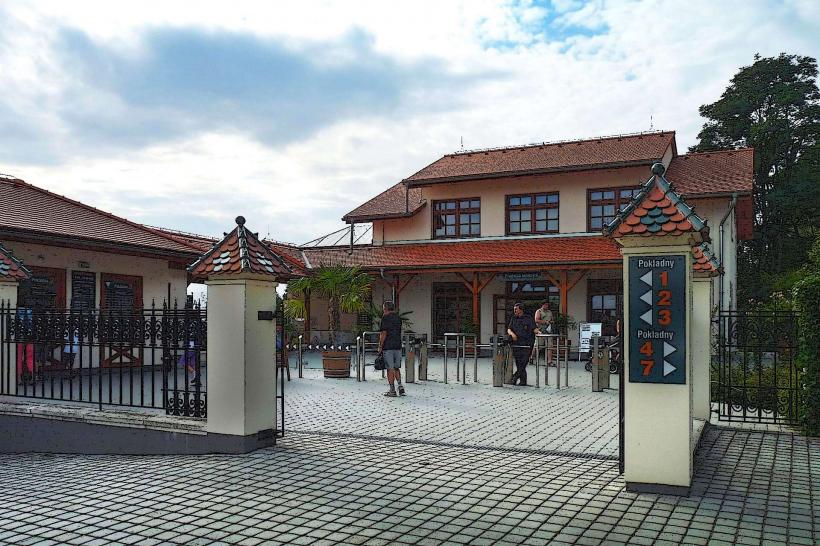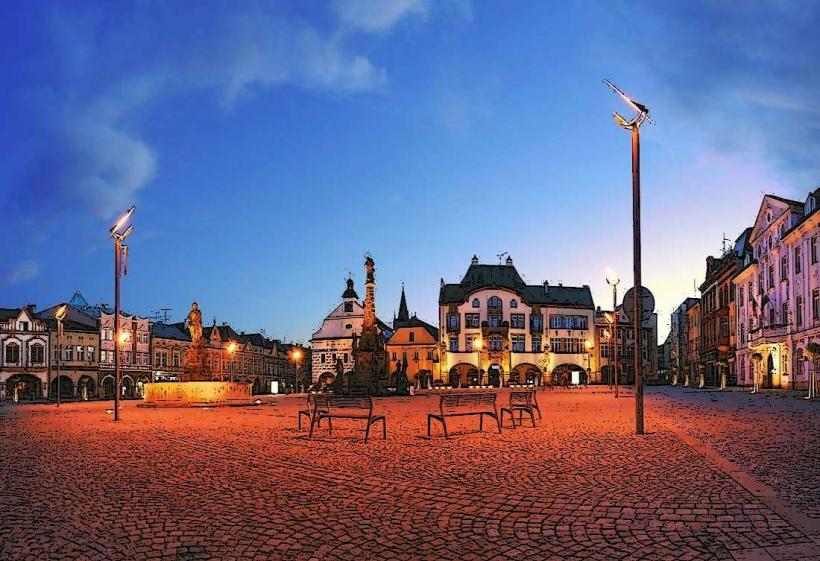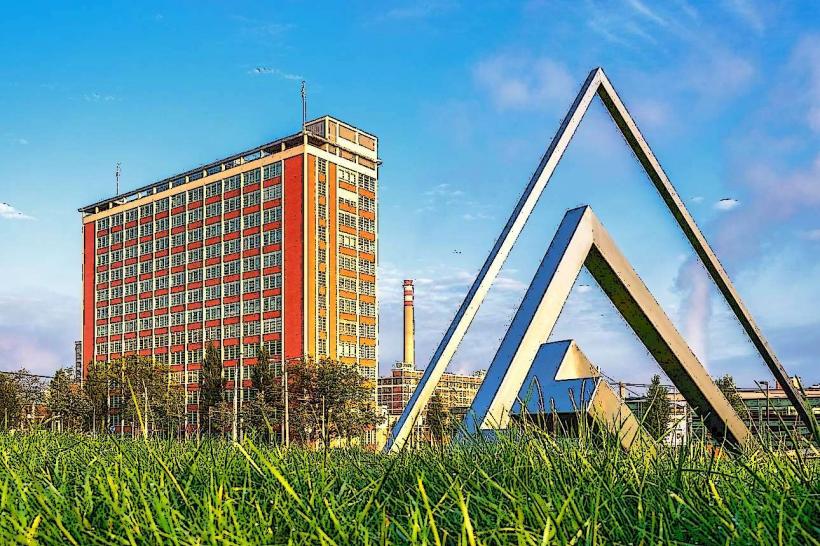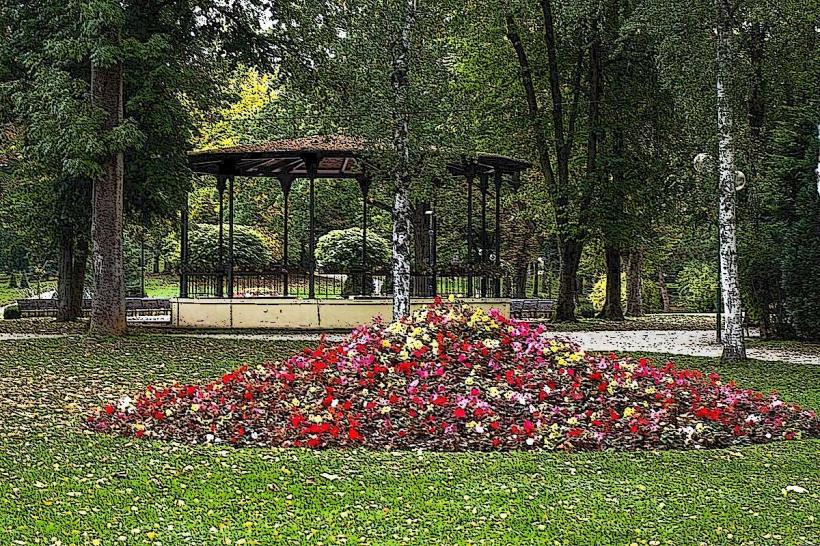Information
City: ZlinCountry: Czech Republic
Continent: Europe
Zlín – Overview without Landmarks
Zlín is a city in the Central Moravian region of the Czech Republic, situated along the Dřevnice River. It is known for its unique historical development, particularly its transformation from a small market town into a major industrial hub in the early 20th century. Zlín is often associated with its development as a center of shoe manufacturing and its iconic Baťa company, which played a major role in shaping the city’s identity and growth.
Geography and Location
Zlín is located in the southeastern part of the Czech Republic, approximately 300 kilometers (186 miles) southeast of Prague and 130 kilometers (81 miles) east of Brno. The city is nestled in the Chřiby Hills and along the Dřevnice River, offering beautiful natural surroundings that include forests and rolling hills. The city’s location makes it an important center for both commerce and transport in the region.
History
Zlín’s history dates back to the 13th century, but the city’s major development began in the early 20th century with the rise of the Baťa shoe company, which played a crucial role in transforming Zlín into a thriving industrial town.
Early History: Zlín was first mentioned in historical records in 1322. Initially, it was a small market town and agricultural center in the region of Moravia. Over the centuries, the city grew slowly, and by the 18th century, it had developed a modest economic base, primarily centered around crafts and trade.
Industrial Revolution and Baťa Company: The most significant turning point in Zlín’s history came with the establishment of the Baťa company in the early 20th century. Founded by Tomáš Baťa in 1894, the company began as a small shoemaking operation but grew rapidly, becoming one of the largest shoe manufacturers in the world. The rise of Baťa’s company led to significant urban development and transformed Zlín from a small town into a major industrial city. The Baťa company also played a key role in shaping the city’s architecture, infrastructure, and social fabric. During the 1920s and 1930s, Zlín became one of the most modern cities in Europe, with an emphasis on modernist and functionalist architecture.
Post-War Period: After World War II and the nationalization of the Baťa company in 1945, Zlín’s industrial base shifted. The city became part of Czechoslovakia’s socialist economy, and its industries were reorganized. While Baťa’s influence waned, the city continued to grow and modernize throughout the communist era.
Post-Communist Era: Following the Velvet Revolution in 1989, Zlín underwent significant economic and social changes. The Baťa company was re-established in the post-communist era as a private enterprise, and the city’s economy diversified. Today, Zlín has a modern economy based on services, industry, and education, and it remains a hub for the footwear industry and fashion design.
Culture and Heritage
Zlín has a strong cultural heritage, with roots in both Czech and industrial traditions. The city is known for its unique combination of modernist architecture, industrial history, and artistic influences.
Modernist Architecture: The most prominent cultural feature of Zlín is its modernist architecture, particularly the Baťa company’s legacy. The city’s Baťa Institute and Baťa’s skyscraper are iconic examples of functionalist design, reflecting the industrial spirit of the time. The city also boasts a variety of modernist buildings that were constructed in the early 20th century, including residential complexes, schools, and commercial buildings.
Film and Animation: Zlín has long been associated with film and animation. It is home to the Zlín Film Festival, one of the oldest and most prestigious film festivals in Europe, focusing on children’s and youth films. The city also has a rich tradition in animation, and the Zlín Film Studios have produced a number of notable Czech animated films.
Art and Design: The city has a thriving cultural scene, with a variety of galleries, theaters, and events throughout the year. Zlín is also known for its design schools and institutions, particularly those focusing on industrial design, graphic design, and fashion design. The Zlín Design Week is one of the city’s key cultural events, bringing together designers and artists from around the world.
Festivals and Events: In addition to the Zlín Film Festival, the city hosts a number of other cultural events, including concerts, art exhibitions, and literary festivals. The city’s cultural calendar is rich with performances, exhibitions, and festivals that celebrate both contemporary and traditional arts.
Economy
Zlín has transitioned from a primarily industrial economy to a more diversified modern economy, although the legacy of its industrial past remains evident in many sectors. The economy is based on manufacturing, services, and education, with a focus on technology and design.
Industrial Legacy: The Baťa company’s legacy continues to influence the city’s economy. Zlín is home to shoe manufacturers, as well as companies involved in fashion, textiles, and mechanical engineering. The city also has a strong presence in the pharmaceutical and chemical industries.
Education: Zlín is known for its focus on education, particularly in the fields of design, engineering, and business. The University of Tomáš Baťa in Zlín is a major educational institution, offering programs in areas such as management, engineering, design, and arts. The university plays an important role in the city’s economic and cultural life, attracting students from around the Czech Republic and abroad.
Services and Technology: In recent years, Zlín has seen growth in the technology and services sectors, particularly in software development, IT, and consulting. The city is becoming a hub for innovation, with a growing number of startups and tech companies emerging.
Tourism: While Zlín is not primarily known as a tourist destination, its unique history, architecture, and cultural events make it an appealing place to visit. The city is also known for its proximity to natural attractions, including the Hostýn Hills and Chřiby Hills, which offer opportunities for hiking, cycling, and nature tourism.
Education and Research
Zlín has a strong educational tradition, particularly in the fields of design, engineering, and business. The city’s university system, research institutes, and vocational schools contribute to its vibrant educational atmosphere.
University of Tomáš Baťa in Zlín: Founded in 2001, the University of Tomáš Baťa in Zlín is one of the key institutions of higher learning in the region. It offers a wide range of programs, with an emphasis on engineering, design, and business, and is recognized for its research and innovation in the fields of material sciences and design.
Research and Innovation: Zlín is home to several research institutes focused on technology, design, and business. The city is also known for its incubators and startup hubs, fostering innovation and entrepreneurship.
Transportation
Zlín is well-connected to the rest of the Czech Republic and neighboring countries through its road and rail networks.
Rail: Zlín has a railway station that connects the city to other parts of the country, including Prague and Brno. The train system offers convenient access to regional and national transportation networks.
Road: The city is located near major highways, including the D1 motorway, which connects Zlín to Prague, Brno, and other key cities. The road network provides efficient access to both domestic and international destinations.
Public Transport: Zlín has a well-developed local public transport system, including trams, buses, and trolleybuses. The city is also bicycle-friendly, with many dedicated bike lanes and paths.
Climate
Zlín has a continental climate, with hot summers and cold winters. The city experiences significant temperature variation between seasons, with moderate precipitation throughout the year.
Winter: Winters in Zlín are cold, with average temperatures often below freezing. Snowfall is common, particularly in the months of December and January.
Summer: Summers are warm, with average temperatures ranging from 25°C to 30°C (77°F to 86°F). Occasionally, the city experiences heatwaves during the summer months.
Spring and Autumn: Both spring and autumn are mild, with temperatures ranging from 10°C to 20°C (50°F to 68°F). These seasons offer pleasant weather for outdoor activities and exploring the city.
People and Language
Zlín has a population of approximately 75,000 people. The primary language spoken is Czech, though English is spoken by some, particularly among younger generations and in the city’s educational institutions.
Conclusion
Zlín is a city shaped by its industrial past and modern transformation into a hub of education, innovation, and design. Its rich history, modernist architecture, and thriving cultural and economic sectors make it a unique and vibrant place in the Czech Republic. Whether exploring its industrial heritage, attending one of its cultural festivals, or enjoying the surrounding natural beauty, Zlín offers a variety of experiences for visitors and residents alike.





